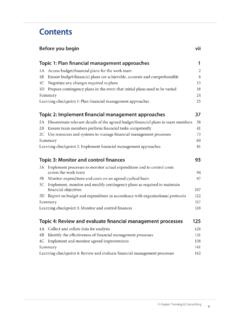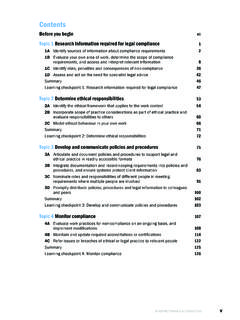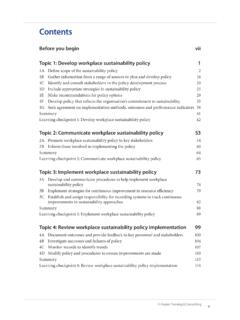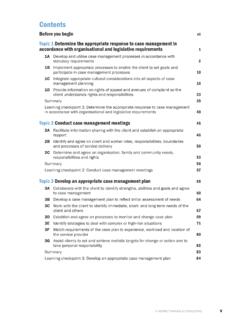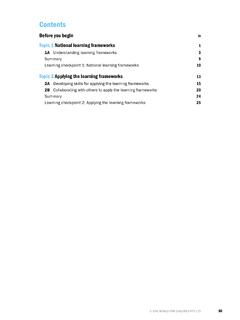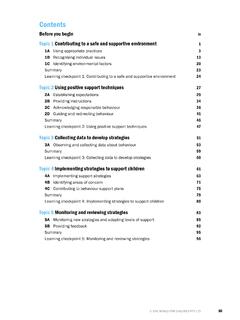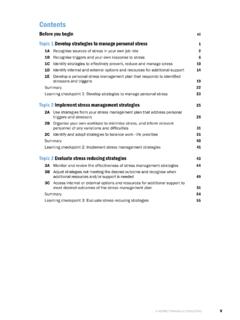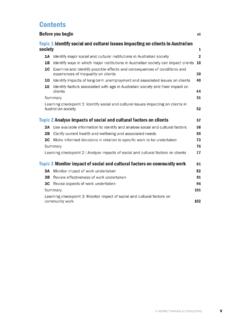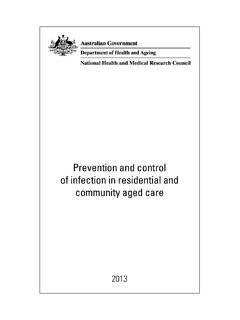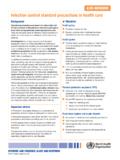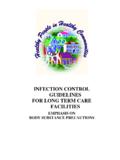Transcription of HLTINF001 Comply with infection prevention and control ...
1 ASPIRE TRAINING & CONSULTING vContentsBefore you begin viiTopic 1 Follow standard and additional precautions for infection control 11A Follow hand hygiene practices to prevent the spread of infection 31B Implement effective hand care procedures 111C Use PPE and ensure it is effective to prevent the spread of infection 181D Follow the procedures for respiratory hygiene and cough etiquette 221E Follow procedures for environmental cleaning 241F Follow procedures to safely handle, transport and process linen to prevent the spread of infection 341G Follow procedures to safely dispose of contaminated waste 371H Follow procedures to handle and clean equipment to prevent exposure, contamination of clothing and transfer of pathogens 481I Identify and respond to situations where additional precautions may be required to prevent transmission of infection 51 Summary 56 Learning checkpoint 1: Follow standard and additional precautions for infection control 57 Topic 2 Identify infection hazards and assess risks 632A Identify infection hazards associated with own role and work environment 642B Identify area of responsibility for infection control 682C Assess the risk of harm from identified hazards 722D Document and report activities and tasks that pose a risk 782E Follow procedures to identify control measures to minimise risk 80 Summary 86 Learning checkpoint 2.
2 Identify infection hazards and assess risks 87 Topic 3 Follow procedures for managing risks associated with specific hazards 913A Implement protocols for care after exposure to blood or other body fluids 923B Place appropriate signs where required 953C Remove spills in accordance with organisational policies and procedures 983D Minimise contamination of materials, equipment and instruments by aerosols and splatter 1003E Identify, separate and maintain clean and contaminated zones 1033F Confine records, materials and medicaments to a well designated clean zone 1053G Confine contaminated instruments and equipment to a well-designated contaminated zone 107 Summary 108 Learning checkpoint 3: Follow procedures for managing risks associated with specific hazards 109 ASPIRE TRAINING & CONSULTING 5 TopiC 1 FOLL OW STANDARD AND ADDITIONAL PRECAUTIONS FOR infection control pathogenXXThe disease causing organismreservoir for the infectionXXAn animal, insect, person, plant, soil, food or object that harbours a diseaseportal of exitXXA way out of the reservoir through saliva, mucous membranes, faeces, blood, or body of transmissionXXInfectious organisms can be spread via direct contact with the microorganism, such as through contact with body fluids or indirectly through an insect portal of entryXXA way onto or into the host s body through skin, cavities.
3 Wounds or inhalationSusceptible hostXXA person who is vulnerable to infectionsStandard precautions to prevent the spread of infectionNot all people who are infected or carry infections look unwell; people who have diseases can be rich or poor, young or old, male or female, look well-presented or have poor personal presentation. You cannot be sure whether or not a person carries a disease just by looking at them. Also, people who are infected or who carry a disease may not be aware of it, and if they are aware, they may choose not to disclose it. You must understand that it is illegal to discriminate against someone on the basis of disability, including disease. Taking standard precautions is the best approach to protect all people from the spread of of the standard precautions to prevent the spread of infection is general hand-washing procedures.
4 Hand hygiene practices and infection controlGerms are everywhere on our skin, in our bodies and on surfaces. Even healthy people can carry infectious bacteria and other pathogens. As a health and community services worker, it is essential that you wash your hands thoroughly and on a regular basis to minimise the spread of infection . The following contains information on the importance of hand-washing when hand hygiene is required. ASPIRE TRAINING & CONSULTING 9 TopiC 1 FOLL OW STANDARD AND ADDITIONAL PRECAUTIONS FOR infection CONTROLH ygienic hand-washingFollow these steps when washing your hands:XXWet your hands thoroughly with soap or skin rub your hands together covering all surfaces of your hands and wrists: palm to palm palm over the back of each hand palm to palm with interlaced fingers tips and back of fingers to each palm clean your thumbs clean your your hands your hands dry using paper off tap with paper of paper hand hygiene practices to prevent the spread of infectionIn the past, some bacterial infections such as staphylococcus aureus (golden staph) were commonly treated with penicillin.
5 Some forms of this bacterium are now penicillin-resistant. For example, methicillin-resistant staphylococcus aureus (MRSA) is a bacterium that can be carried by asymptomatic as well as symptomatic people. MRSA can cause infections of the skin, as well as life-threatening infections of the brain, bones, lungs, heart, blood vessels and is one of the most effective ways to prevent the spread of Comply WITH infection prevention AND control POLICIES AND PROCEDURES providing different types of care for a personXXGloves need to be disposed of after performing a task on one part of the body. General hand wash procedure should then occur before putting on another pair of gloves and performing a second task on a different part of the of glovesGloves are primarily designed to prevent the transmission of infection between clients and workers, but can also be used as barriers against infections from other sources such as urine, vomit or faeces.
6 The following outlines the four main types of disposable gloves are appropriate for use when providing personal care. They act as a barrier between you and the client. These gloves must only be used once, and then disposed of immediately and appropriatelySterileSterile disposable gloves also act as a barrier between you and the client. They should be worn for wound dressings with direct contact, aseptic techniques and endotracheal or tracheostomy purpose utility gloves, also known as rubber gloves, are normally worn when cleaning, washing dishes or other equipment, or handling chemicals. These gloves act as a barrier between your hands and the water and dutyHeavy duty gloves should be used when carrying out maintenance duties such as gardening or using certain chemicals. Read the relevant safety data sheet (SDS) before using any chemical to find out whether heavy duty gloves are requiredCover cuts and abrasions with waterproof dressings and change dressings as necessaryThe skin acts a protective barrier, preventing the spread of infection from person to person.
7 Any skin breakage such as a scratch (a supe rficial skin injury), cut (an open wound) or abrasion (an area of skin scraped or worn down through friction) that compromises the in tegrity of the skin can act as a portal for infections to travel from and to the body. ASPIRE TRAINING & CONSULTING ASPIRE TRAINING & CONSULTING 19 TopiC 1 FOLL OW STANDARD AND ADDITIONAL PRECAUTIONS FOR infection CONTROLto protect the person you are supporting if they have a lowered immunity. The gown or apron you wear should reflect your organisation s policies and procedures. Here is some information relating to the types and usage of gowns and of gowns availableXXAprons are often made out of plastic and are waterproof. Gowns may be short-sleeved or long-sleeved, and can be made out of a range of materials with various levels of water aprons and gowns are disposable, while others can be laundered by following the AS/NZS 4146:2000 Standard for laundering.
8 Aged care and HACC workers rarely require sterile a gown or apronXXWhen a gown or apron is required, you must put it on just before coming into contact with the client. Timing is critical. If you put the gown or apron on too early, it is likely that it will become contaminated and it may pose an infection risk to the client. If you do not put the gown or apron on until after initiating contact with the client, you may be exposed to body fluids and other infection , goggles and face shieldsGlasses, goggles and face shields should be worn when your eyes are likely to be exposed to splatter. If your mouth is also likely to be exposed, wear a face shield instead of glasses or goggles. The following are guidelines for effective use of glasses, goggles and face glasses, goggles and face shieldsXXProtective glasses cannot be worn over prescription are a better alternative for people who need prescription glasses to putting on glasses or goggles, check that they are not damaged and that they will fit you not touch the outer surface of the glasses, goggles or face the PPE by touching the arms or for the effective use of footwear are shown effective footwearXXYour shoes should be comfortable and supportive to protect your feet from bruising and blisters and to reduce the likelihood of back shoes with non-slip soles to reduce the likelihood of slips and falls.
9 ASPIRE TRAINING & CONSULTING 25 TopiC 1 FOLL OW STANDARD AND ADDITIONAL PRECAUTIONS FOR infection CONTROLS chedulesMost facilities have cleaning schedules for all areas including communal areas, staff-only areas and clients rooms or homes. These schedules contain information about:XXthe tasks that must be completedXXthe personnel responsibleXXwhen the tasks must be logs are usually in table form and contain information about what must be cleaned and when it must be cleaned. It is the responsibility of each worker to update cleaning logs by placing a tick, initials and the time and date next to the relevant task. This helps other workers and coordinators establish which cleaning tasks have been completed and which ones still need to be done. It also assists with auditing and quality control dutiesAs with all work activities, there should be policies and procedures that provide staff with a framework for making sure they complete the cleaning tasks in the safest and most efficient way duties may include:XXsurface cleaning procedures at the start and end of each day or shift to make sure the area is ready for useXXroutine surface cleaning done at scheduled times throughout the day to ensure the areas stay clean and meet policies and proceduresXXmanaging a blood or body fluid spill (which could occur at any time of the day).
10 Personal protective equipmentIt is essential that workers know the type of PPE they are required to wear for their various tasks. You should receive training in the correct way to wear PPE during your induction, but if you have forgotten, ask a colleague or your supervisor. Some critical points regarding the use of PPE are outlined ppeXXIn most cleaning situations, gloves and aprons are there is risk of splashing waste into the face or eyes, face shields should also be can only work if it is intact and undamaged, is fit for the purpose and is worn correctlyXXMake sure the PPE fits you you notice any damaged PPE, notify your supervisor immediatelyXXBe familiar with the type of clothing you are required to wear for the purpose; for example, should the apron be waterproof? ASPIRE TRAINING & CONSULTING 29 TopiC 1 FOLL OW STANDARD AND ADDITIONAL PRECAUTIONS FOR infection CONTROLThe importance of workflowPlanning your cleaning tasks will save you time.

